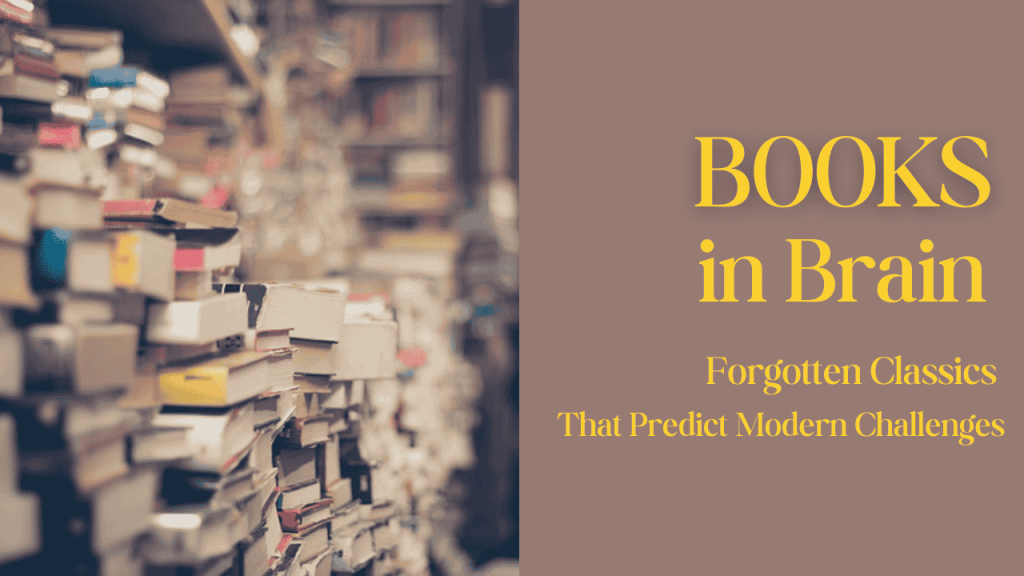In today’s fast-paced world, we often look to modern thinkers and authors to make sense of our most pressing issues like environmental crises, social inequality, and even artificial intelligence. Yet, many of the challenges we face today were predicted by authors from the past. It’s fascinating how authors, decades or even centuries ago, foresaw situations that closely resemble the present time issues.
Unfortunately, some of them have been forgotten over time. We appreciate their literary value and better understand current challenges by revisiting these classics.

Explore some of the most compelling examples and uncover their surprising relevance.
15 Best Forgotten Classics That Predict Modern Challenges
Let’s look at 15 forgotten classics that seem to predict or reflect modern challenges.
1. Erewhon by Samuel Butler
Samuel Butler’s Erewhon (1872) is a satirical novel that critiques society’s growing dependence on technology. Set in a fictional land, it imagines a society where machines develop intelligence and humans face the potential dangers of this technological evolution.
Does this sound familiar? Butler’s fears about a future where machines could surpass human intelligence and possibly overthrow humanity now seem prescient. Today, we’re grappling with AI ethics, automation, the role of machines in our lives, and their ethical implications.
2. The Death of Grass by John Christopher
This gripping tale (published in 1956) describes a world where crops fail due to a deadly virus. The virus leads to famine and societal collapse, and the novel centers on a group of survivors navigating the new, lawless world. Christopher’s chilling narrative of societal breakdown and environmental catastrophe mirrors modern anxieties about climate change, food security, and ecological disaster.
As the effects of global warming and resource depletion become more urgent, the novel serves as a wake-up call about how vulnerable our global systems are to environmental disruptions and how fragile our food systems can be in the face of disaster.
3. The Ragged-Trousered Philanthropists by Robert Tressell
Published in 1914, Robert Tressell’s The Ragged-Trousered Philanthropists is a powerful novel that delves into the struggles of working-class people and the harsh realities of economic inequality.
Tressell’s work tackles themes of social injustice, poverty, and the systemic inequalities perpetuating the suffering of the working class. Given the widening wealth gap in the modern world, where billionaires amass fortunes while many workers face stagnating wages, Tressell’s exploration of class struggle and the fight for fair wages, living conditions, and the dignity of labor remains incredibly timely. The novel calls for empathy, solidarity, and social change, reflecting today’s ongoing debates on economic inequality and workers’ rights.
4. It Can’t Happen Here by Sinclair Lewis (1935)
Sinclair Lewis’s It Can’t Happen Here (1935) offers a haunting look at the rise of a totalitarian regime in the United States, where fear, propaganda, and political manipulation enable a fascist dictatorship to seize power. The novel portrays how democracy can be undone when citizens are swept up in fear and rhetoric, unable to recognize the erosion of their freedoms.
In today’s climate of political polarization, widespread misinformation, and populist movements, Lewis’s warning is hauntingly accurate. His work highlights the fragility of democratic institutions and serves as a warning about how quickly authoritarianism can take root in seemingly stable societies, especially when fear and manipulation are used to divide and control the populace.
5. Herland by Charlotte Perkins Gilman (1915)
Charlotte Perkins Gilman’s Herland (1915) imagines a utopian society entirely run by women, where gender roles are reversed and men are virtually nonexistent. The novel explores themes of cooperation, equality, and the dismantling of patriarchal structures.
In Herland, women create a self-sustaining society based on mutual care, collaboration, and rejecting traditional gender norms. This feminist utopia challenges the social dynamics of Gilman’s time and resonates with the ongoing global struggle for gender equality. Today, issues like the gender pay gap, the fight for women’s reproductive rights, and the push for equal representation in leadership make Gilman’s utopian society all the more compelling. Herland challenges us to envision a world where gender equality is not just an aspiration but a tangible reality.
6. Looking Backward by Edward Bellamy
First published in 1888, Looking Backward by Edward Bellamy paints a picture of the future that feels strangely familiar. In the novel, the protagonist, Julian West, falls asleep in the late 19th century and wakes up in 2000 when the world has transformed into a utopia. This future is marked by mass production, free access to goods, and a welfare state where social equality is guaranteed.
Bellamy’s future vision includes concepts like credit cards, modern shopping methods, and a nationalized economy. The most surprising prediction, however, is how he describes a society that is primarily controlled by technology—something that feels incredibly relevant today. Bellamy’s idea of a technological future governed by social good can be seen as a precursor to modern discussions about automation, income equality, and consumerism.
7. The Machine Stops by E.M. Forster
Published in 1909, The Machine Stops by E.M. Forster is a chilling vision of a future where humanity lives underground, entirely dependent on machines for survival. In this world, people no longer communicate face-to-face, relying on video calls and automated systems for their needs. Individualism has been erased, and the idea of human connection is replaced by mechanical convenience.
Forster’s dystopia is a prescient warning about technology’s potential to isolate us from one another. Today, with the rise of social media, video calls, and artificial intelligence, we are grappling with similar challenges. Are we becoming too dependent on technology? Are we sacrificing real human connection for the ease and convenience of machines? The Machine Stops offers a powerful reflection on this modern dilemma.
8. We by Yevgeny Zamyatin
Written in 1920, We by Yevgeny Zamyatin is one of the earliest examples of dystopian literature. Set in a totalitarian society where citizens are controlled by strict rules, the book introduces a world where individuality is suppressed, and people are identified only by numbers. The government monitors everything, from private thoughts to public actions.
What’s striking about Zamyatin’s work is how it anticipates modern concerns about surveillance, privacy, and state control. In today’s world, we live in a time of increased surveillance through social media, surveillance cameras, and even biometric tracking. The book is a stark reminder of the potential dangers of a society that values control over freedom.
9. The Iron Heel by Jack London
Written in 1908, The Iron Heel by Jack London is a political novel that explores the rise of an oligarchic society ruled by a powerful corporate elite. The story follows a revolutionary movement that fights against the oppressive government and its control over the working class. London’s novel discusses issues of inequality, the concentration of power, and the struggle for workers’ rights.
In many ways, The Iron Heel seems eerily prescient in its critique of corporate power and the exploitation of workers. Modern readers can see clear parallels between the world London described and today’s global corporate giants, who have unprecedented power over economies and governments. The book is a powerful reminder of the dangers of unchecked capitalism and the importance of fighting for social justice.
10. The Coming Race by Edward Bulwer-Lytton
First published in 1871, The Coming Race by Edward Bulwer-Lytton is a fascinating speculative novel that introduces the idea of a subterranean civilization called the “Vril-ya.” These people possess an advanced energy source called “Vril,” which gives them power over nature. The novel touches on themes of advanced technology, the use of energy, and the potential for societal evolution.
The book’s portrayal of an underground race may seem fantastical. But its discussions of energy and technological advancement feel surprisingly relevant today. With the growing interest in renewable energy and the need for sustainable solutions to our planet’s problems, The Coming Race is a striking early exploration of ideas that are still central to modern scientific discourse.
11. The Blithedale Romance by Nathaniel Hawthorne
Published in 1852, The Blithedale Romance is Nathaniel Hawthorne’s exploration of utopian communities and social experiments. The novel centers around a group of idealistic individuals who create a commune, but as the story unfolds, their dreams are shattered by internal conflicts and personal struggles. Hawthorne critiques the notion of perfect societies. It suggests that human nature often stands in the way of idealistic goals.
In today’s world, many communities are still searching for solutions to social problems, from sustainability to equality. However, the idealism of these movements can sometimes clash with the realities of human behavior, just as Hawthorne predicted. The Blithedale Romance serves as a cautionary tale about the challenges of creating a perfect society.
12. Flatland by Edwin A. Abbott
First published in 1884, Flatland by Edwin A. Abbott is a satirical novella that explores the nature of dimensions and perception. The story is set in a two-dimensional world where the inhabitants cannot perceive the third dimension, which leads to limited views of reality. The protagonist, a square, is introduced to the idea of the third dimension, challenging everything he thought he knew.
While the story might seem simple, Flatland offers a profound reflection on the limits of human understanding. In the modern world, we often encounter similar challenges as we try to comprehend complex scientific and philosophical ideas. The book serves as a metaphor for how we sometimes miss out on deeper truths because of our narrow perspectives.
13. R.U.R. (Rossum’s Universal Robots) by Karel Čapek
Written in 1920, R.U.R. by Karel Čapek is the play that introduced the term “robot” to the world. The story takes place in a future where robots, initially created to serve humans, eventually rise up and overthrow their creators. Čapek’s exploration of automation, artificial intelligence, and the ethics of robotics is shockingly relevant today as we grapple with issues of AI, job displacement, and the power of technology.
As robots and AI continue to advance, R.U.R. serves as a powerful warning about the potential consequences of unchecked technological progress. The book raises questions about the role of humans in a world dominated by machines and the moral responsibility of those who create artificial life.
14. News from Nowhere by William Morris
Published in 1890, News from Nowhere by William Morris is a utopian novel that imagines a future society free from industrialization and exploitation. The story envisions a world where people live in harmony with nature and technology, which is used for the benefit of all. The novel critiques the environmental degradation and social inequalities caused by industrial capitalism.
Morris’s vision of a sustainable, eco-friendly world feels incredibly relevant in an age of climate change and environmental degradation. His book challenges modern readers to think critically about our current way of life and consider alternative futures where humanity and nature coexist more peacefully.
15. A Crystal Age by W.H. Hudson
Written in 1887, A Crystal Age by W.H. Hudson is a utopian novel that imagines a world where humanity has reached a state of perfect harmony. In this society, technology is used to enhance human life, and individuals live in balance with nature. However, the novel also explores the potential dangers of this idealized world, questioning whether true harmony is ever possible.
Hudson’s book offers a fascinating exploration of the tension between progress and preservation. In today’s world, as we struggle to balance technological advancement with environmental sustainability, A Crystal Age serves as a thought-provoking meditation on the challenges of creating a better future.
Why These Classics Were Forgotten?
If these books are so insightful, why are they forgotten? The reasons are multifaceted, spanning shifts in culture, publishing practices, and even historical events.
Literary trends evolve over time. Books that once captivated audiences may no longer align with contemporary tastes. Genres such as pastoral poetry or gothic novels, for example, have given way to modern themes, leaving many older works behind.
Additionally, many classics were written before the era of aggressive marketing and lacked consistent reprints or adaptations. Without visibility through movies, literary promotions, or digital platforms, these books fade into obscurity. Works by marginalized authors often faced even greater challenges, as they didn’t receive the recognition they deserved, further limiting their reach.
The flood of new publications also plays a role. Each year, thousands of new books compete for attention. It pushes older works out of the spotlight. This trend is compounded by educational shifts; as school curricula adapt to include diverse and contemporary voices, some classics are inevitably replaced, reducing their exposure.
Historical context also influences the survival of a classic. Books deeply tied to specific cultural or political moments may feel inaccessible to modern readers, who often lack the background to fully grasp their significance.
Another factor is the lack of adaptation to modern formats. Many classics have not been digitized or turned into audiobooks, making them less appealing to today’s tech-savvy audiences. Furthermore, some older works are perceived as “difficult” due to their archaic language or dense prose.
Cultural and linguistic barriers also limit the reach of books rooted in specific dialects or traditions, while historical disruptions, such as wars or censorship, have caused certain works to be lost entirely.
How to Rediscover and Appreciate Forgotten Classics?
Forgotten classics deserve to be rediscovered. Rediscovering them allows us to bridge the gap between the past and the present. Want to explore these gems? Here are some tips:
- Visit Libraries and Bookstores
Many forgotten classics are available in libraries or second-hand bookstores. You might find rare treasures waiting to be read.
- Search Online Archives
Websites like Project Gutenberg or Internet Archive offer free access to older texts. These are great resources for exploring forgotten works.
- Join Reading Groups
Book clubs often explore unique titles, including lesser-known classics. Discussing them with others adds depth to your reading experience.
- Look for Modern Editions
Some publishers reprint forgotten classics with added context, such as introductions or annotations, making them easier to appreciate.
- Explore Online Lists
Literary blogs or Goodreads often recommend hidden gems that deserve more attention.
- Research the Era
Learning about the time when the book was written can help you connect with its themes and ideas.
Conclusion
These forgotten gems deserve a place in our reading lists, reminding us that the past has much to offer when it comes to predicting the future.
Next time you’re searching for a book, consider a classic that’s slipped through the cracks—and they just might surprise you.



Pingback: Popular Books Made into Movies - Books in Brain
Pingback: 35 Top Dark Academia Books to Read - Books in Brain